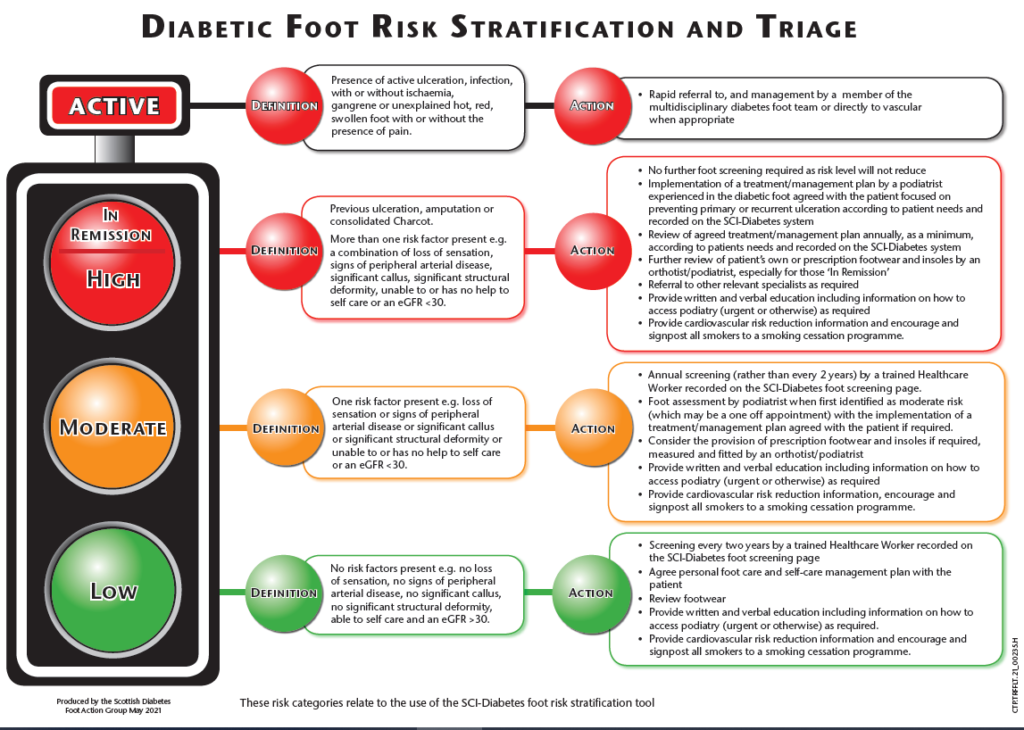Information
The Diabetic Foot Risk Stratification and Triage Guidelines, published by The Scottish Diabetes Foot Action Group, are used within NHS Lothian to determine the most appropriate management plan. Those seen within the service are managed predominantly in the community podiatry clinics.
New referrals, and complex cases, of active ulceration are managed by our Advanced Diabetes Team at our acute hospital sites at the Royal Infirmary of Edinburgh, Western General Hospital and St John’s Hospital. The Diabetic Foot Clinics aim to see all new referrals within two working days.

Who to refer:
Please only refer those who fall into the following categories:
- Moderate Risk – has at least one risk factor, for example, loss of sensation, signs of peripheral arterial disease, unable to or has no help to self-care or an eGFR <30. Refer to podiatry when first identified as moderate risk for an agreed treatment and management plan to be put in place.
This may be a one-off appointment.
- High Risk – more than one risk factor present.
- In Remission – has had previous ulceration, amputation or a consolidated Charcot joint.
- Active foot disease – has current ulceration.
If a person has a limb-threatening or life-threatening diabetic foot problem, refer them immediately to acute services. Examples of limb-threatening and life-threatening diabetic foot problems include the following:
- Ulceration with fever or any signs of sepsis.
- Ulceration with limb ischaemia (see the NICE guideline on peripheral arterial disease).
- Clinical concern that there is a deep-seated soft tissue or bone infection (with or without ulceration).
- Gangrene (with or without ulceration)
For all other active diabetic foot problems, refer the person within one working day to the diabetic foot clinic for triage within one further working day
Who not to refer:
- Low risk or newly diagnosed individuals who do not have a podiatric need – any appropriately trained healthcare professional or clinical support worker can carry out foot screening.
How to refer:
- Secondary care HCP’s can refer using the forms on the Podiatry intranet site
- Diabetic Foot Clinic for active ulceration – SCI Gateway (RIE, WGH or SJH)
- Moderate/High/In Remission – Podiatry Community Clinics via SCI Gateway
Contact Details
Multidisciplinary Foot Team
OPD2, Royal Infirmary of Edinburgh
Tel: 0131 242 1453
Loth.riepodiatrydiabetes@nhs.scot
Diabetic Foot Clinic, Metabolic Unit
Western General Hospital
Tel: 0131 537 1297
Loth.wghpodiatrydiabetes@nhs.scot
Diabetic Foot Clinic
OPD1, St John’s Hospital
Tel: 01506 523 175
loth.wlpodiatrydiabetes@nhs.scot
If infection is suspected in an active foot ulcer at presentation to Primary Care service, please ensure a tissue/bone sample or swab is obtained prior to prescribing empiric antibiotics.
Any wound should be covered with an appropriate dressing and kept dry until attendance at the podiatry clinic.
See Foot Ulceration Section
Training, including an online module, for conducting diabetic foot assessments can be found at www.diabetesframe.org
Patient information leaflets for risk categories and other specific conditions can be found and downloaded from https://www.diabetesinscotland.org.uk/publications/#leaflet-docs
(327) NHS Scotland SoleSafe Instructional Video – YouTube
(327) NHS Scotland HeelSafe Instructional Video – YouTube
(327) NHS Scotland FootSafe Instructional Video – YouTube
SIGN Guideline – Management of Diabetes: https://www.sign.ac.uk/assets/sign116.pdf
NICE Guideline – Diabetic Foot Ulcers: https://www.nice.org.uk/guidance/ng19/chapter/Recommendations#diabetic-foot-ulcer
NICE Guideline – Peripheral Arterial Disease: Overview | Peripheral arterial disease: diagnosis and management | Guidance | NICE













